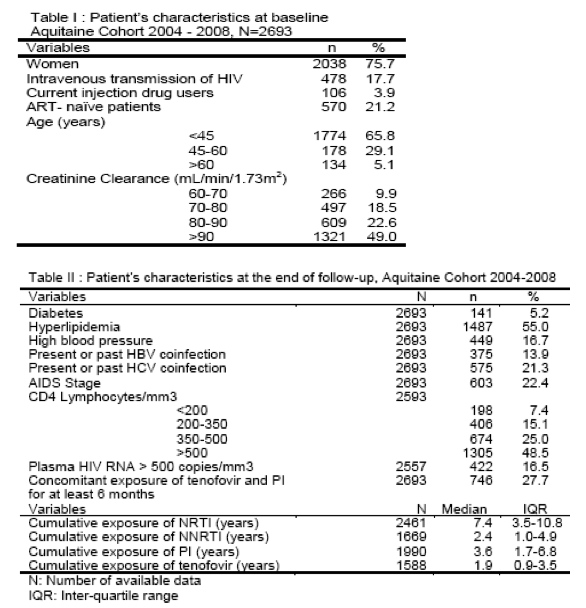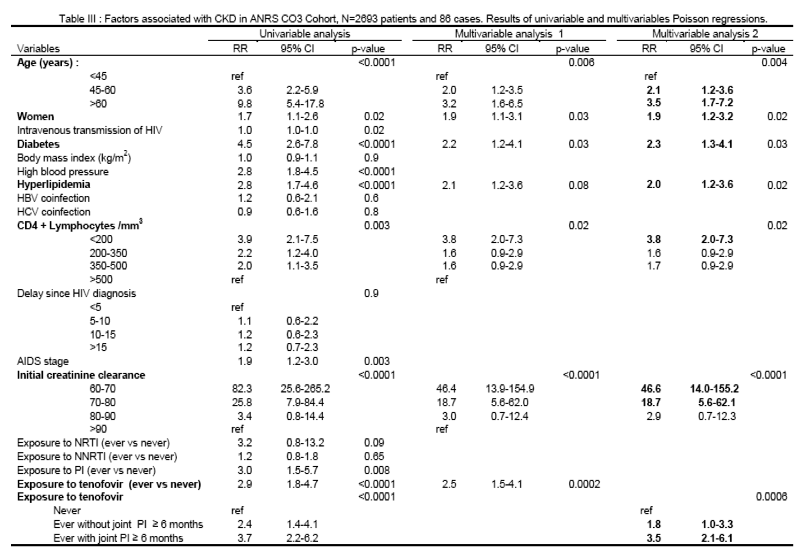 |
 |
 |
| |
Antiretroviral drugs and incidence of chronic kidney disease, ANRS CO3 Aquitaine Cohort, France, 2004-2008
|
| |
| |
Reported by Jules Levin
Presented at IAS 2011 - Rome, Italy
P. Morlat1,2, A. Vivot2,3, F. Dauchy1, J. Asselineau3, M-A. Vandenhende1,
E. Lazaro1,Y. Gerard4, F. Bonnet1,2, D. Neau1, P. Mercie1,2, E. Deti2, G. Chene1,2,3,
for the Groupe d'Epidemiologie Clinique du SIDA en Aquitaine (GECSA)*
1. CHU Bordeaux, Coordination Regionale pour la Lutte contre le VlH (COREVIH), Bordeaux, France
2. INSERM, U897 ; Universite Bordeaux Segalen, Bordeaux School of Public Health (ISPED)
3. CHU Bordeaux, Pole de Sante Publique, 4. Dax Hospital, Service de maladies infectieuses
Author Conclusion
In this hospital-based cohort, a preexisting mild renal dysfunction (60< CC<80mL /min/1.73m2) was the main risk factor associated with higher incidence of CKD. Other determinants included female gender, older age, diabetes, hyperlipidemia and lower CD4 cell count. Patients exposed with tenofovir were also at higher risk, and this risk was increased by the concomitant prescription of PI/r.
This interaction between tenofovir and PI/r on nephrotoxicity in HIV-infected patients should be confirmed in independent databases allowing also to examine whether this effect is homogeneous
or not among different PI/r.
Meanwhile, use of tenofovir, mainly when co-administered with PIs, requires careful consideration when other risk factors of CKD are present.
From Jules: In Table 3 with Univariate analysis risks for chronic kidney disease: age (45-60 RR 3,8, >60 RR 9.8); diabetes RR 4,5), high blood pressure (RR 2.8); hyperlipidemia (RR 2.8); CD4 count <200 RR 3.9, CD4 200-350 RR 2.2, CD4 350-500 RR 2.0, reference CD4 >500); AIDS Stage (RR 1.9); initial creatinine clearance 60-70 (RR 82.3), 70-80 (RR 25.8), 80-90 (RR 3.4), >90 reference); exposure to PI (ever vs never) (RR 3.0); exposure to TDF (ever vs never) (RR 2.9); expososure to TDF ever without joint PI >6 months (RR 2.4), ever with joint PI >6 months (RR 3.7). After multivariate analysis exposure to TDF ever without joint PI >6 months: RR 1.8, ever with joint PI >6 months RR 3.5.
Introduction
Background. Chronic kidney disease (CKD) has become common among HIV-infected patients in industrialized countries. The nephrotoxicity of tenofovir has been widely reported but the impact of boosted protease-inhibitors (PI/r) is discussed [1,2]. Indeed, two previous reports showed a greater reduction in calculated glomerular filtration rate when tenofovir was used with a Pi/r [3, 4]; this could be due to an increase of tenofovir exposure of 20-30% by some PI/r containing regimens [5]. Thus the respective roles of all potential risk factors of CKD [traditional, HIV-related and antiretroviral drugs (ART)] remain to be clarified.
Objective. To examine the role of antiretroviral drugs on the incidence of CKD in HIV-1 infected patients. We hypothesised that tenofovir might be associated with a higher rate of nephrotoxicity when associated with PI/r.
Methods
Design and study population. Patients of the ANRS CO3 Aquitaine Cohort with baseline Creatinine Clearance (CC) > 60 mL/min/1.73m2 were followed-up from January 2004 to December 2008.
The ANRS CO3 Aquitaine Cohort recruits patients through a hospital-based information system on HIV-1 infection in the Bordeaux University Hospital in the Aquitaine region, South Western France.
Case-definition: Incident cases of CKD were defined as at least two consecutive measurements of CC<60 mL/min/1.73m2 in a ≥ 3 months period. CC was estimated using the Modification of Diet in Renal Disease
formula (MDRD).
Statistical analysis: Poisson regression models for ungrouped data were used to investigate determinants of CKD either measured at baseline or updated: [CD4+ lymphocytes count, HIV-RNA, exposure to ART, high blood pressure, diabetes, hyperlipidemia, AIDS stage, Hepatitis B Virus (HBV) co-infection, Hepatitis C Virus (HCV) co-infection, plasma HIV RNA, and cumulative exposure to ART]. In an additional analysis, exposure to tenofovir was studied with and without concomitant administration (> 6 months) of PIs.
Results
During a median follow-up of 3.4 years, 2692 patients were included, i.e 8,477 person-years of follow-up. Baseline characteristics are shown in table I, characteristics at the end of follow-up for time-varying variables are shown in table II.

At the end of follow-up, 86 patients had CKD, the average incidence rate of CKD was 10.1 cases per 1000 person-years (95% Confidence Interval [CI] 8.3-12.7).
Median number of CC measures per patient was 10, IQR (6-13).
Almost all patients (95%) had received ART (median total cumulative exposure 7.6 years), among whom 35% jointly received tenofovir and a protease inhibitor (PI) for at least 6 months [atazanavir/r (41%), lopinavir/r (35%), fosamprenavir (11%), saquinavir (4%), and others (9%)].

Table III displays univariable analyses and two multivariable models: first with tenofovir exposure classified as ever/never and second with tenofovir exposure classified in three ways: never, ever with joint
exposure to PI during at least 6 months, ever without joint exposure to PI during at least 6 months (i.e without PI or with previous exposure to PI or with joint exposure to PI during less than 6 months).
Among patients who have developed CKD, 96% had a baseline CC between 60 and 90 ml/min/1.73m2, and 90% had at least three traditional risk factors of CKD at baseline.
References
[1] Gallant JE, Moore RD. AIDS 2009; 23: 1971-5
[2] Mocroft A, Kirk O, Reiss P et al. AIDS 2010; 24: 1667-8
[3] Fux CA, Simcock M, Wolbers M et al. Antiv Therap 2007; 12 : 1165-73
[4] Goicoechea M, Liu S, Best B et al. J Infect Dis 2008; 197 : 102-8
[5] Kearney BP, Mathias A, Mittan A et al. J Acquir Immune Defic Syndr 2006; 43:278-83
|
| |
|
 |
 |
|
|